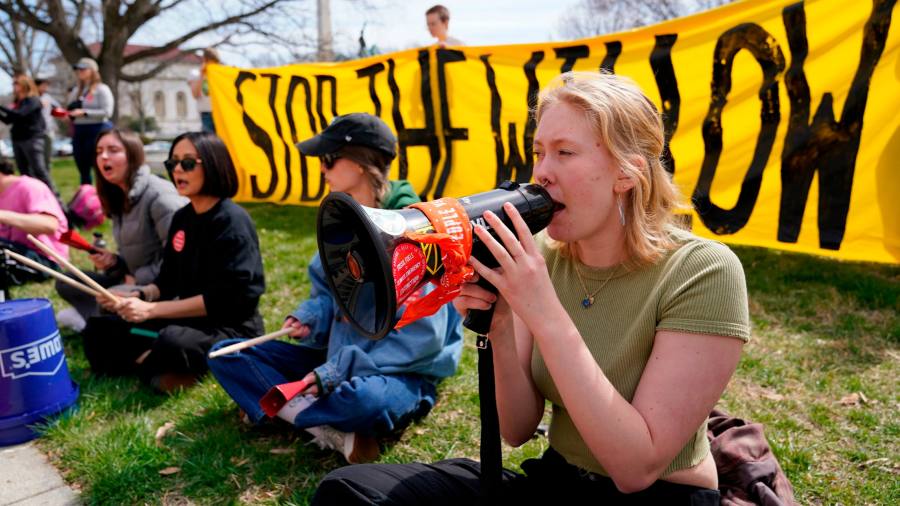
On TikTok, a campaign to deny ConocoPhillips permission to launch an oil project in Alaska recently went viral. Look up the hashtag #StopWillow and the search results are full of protests warning of the potential damage the project could wreak. One video, which has been liked 3.4mn times, declares that approval would be “game over” for the planet.
As impassioned as the campaign was, it did not work: Joe Biden approved the drilling on March 13. The president had given ConocoPhillips almost everything it wanted, said Elise Joshi in one TikTok clip. “Biden just slapped young people in the face.”
Willow isn’t huge: Conoco says the $8bn project will produce 180,000 barrels a day of oil, or about 1.5 per cent of current US supply. Since Biden entered office, New Mexico’s shale wells alone have added more than 700,000 b/d. Still, approval came just days before the UN’s Intergovernmental Panel on Climate Change warned, again, of the catastrophe facing the world from existing fossil fuel infrastructure, let alone new projects that will pump for decades.
And the shift from Biden is telling. Fossil fuel interests are on the rise again. Biden entered office promising to ban new fracking and last year signed sweeping clean energy legislation into law. Now his administration promotes liquefied natural gas exports and boasts that US oil output will soon reach record highs.
European countries such as Germany that once pledged to stop funding fossil fuel projects in the poor world last year fired up their own coal plants and now seek to water down EU climate rules.
It marks a reversal from three years ago, when the pandemic shattered global fossil fuel demand, devastated Big Oil balance sheets and prompted claims that the decarbonisation era had begun. Russia’s invasion of Ukraine is one reason for the turn. It has been a gift for the oil industry, pushing up prices and delivering record profits for producers.
For ExxonMobil and Chevron, the cash windfall has vindicated their dogged allegiance to a model of ever-rising fossil fuel output. For supermajor BP, the cash gusher has justified another decision to slow its retreat from oil and gas. Russia’s invasion has also changed the narrative. The stages at Davos still ring with “net zero” platitudes, but after last year’s energy crisis politicians’ concern is “energy security” — code for cheap fuel and stable supplies.
That’s why European governments ramped up subsidies for energy consumers last year and the White House released oil from strategic stockpiles while badgering shale companies to frack more wells. “We’re in the middle of a war,” US energy secretary Jennifer Granholm told the Financial Times in March. “We want to continue to see that increase in production even as we accelerate towards clean [energy] . . . We don’t want the prices to go up at the pump.”
Europe’s energy anxieties have been an especially big win for American fossil fuel exporters. “The key to energy security is American energy — and specifically US LNG,” Toby Rice, head of EQT, the US’s biggest gas producer, told Houston’s recent CERAWeek energy conference. Now, with Biden’s backing, another wave of LNG export capacity is under construction on the US Gulf Coast.
But the other reason that fossil fuel producers are gaining momentum again is that the energy transition is proving more fraught than some strategists expected.
The environmental, social, and governance movement was supposed to accelerate the transition by making capital cheap for clean energy projects, while deterring investment in more fossil fuel production.
Oil and gas capital spending has indeed fallen and many fund managers have left the sector for good. Wood Mackenzie reckons annual global upstream spending was $491bn last year, less than half the rate of investment from a decade ago. This level of upstream spending would be adequate if the world’s fossil fuel consumption was falling at the pace some models say is necessary to meet climate goals.
The problem is that consumers are not ditching hydrocarbons as quickly as those models would like. Fossil fuel consumption is soaring. Oil demand will break records again this year.
Renewable alternatives are rising fast but still supply less than 10 per cent of global energy. Annual spending on them is running at barely a quarter the $5tn needed to displace hydrocarbons, according to the International Renewable Energy Agency.
This dearth of capital amounts to “a self-inflicted train crash in slow motion”, according to Equinor’s chief economist Eirik Wærness. It implies higher demand and higher prices for oil and gas for longer. It’s also why Biden didn’t #StopWillow. If consumers are to keep burning so much oil, is it better coming from Alaska or Saudi Arabia?